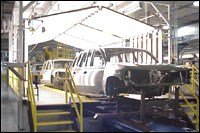GM Truck Plant Uses High-Output Lighting for Paint Inspection
The perpendicular lighting fixtures provide GM with the ability to detect paint and metal imperfections, allowing them to correct flaws and enhance finishes…
A new General Motors high-output lighting system for coating and inspecting the finish on sport utility vehicles recently began production in Oklahoma City, OK. It will expand the company's production of Chevrolet Trailblazers and GMC Envoys and other SUV products.
The new 250,000 sq-ft paint shop facility replaced an older paint facility during refurbishing and conversion of the standard car plant to SUV production. It features a flexible lighting system for both general purpose and task painting illumination. It has a series of painting booths and inspection decks also containing high-volume filtered air-conditioning in its quality control lines.
Installed throughout the new facility to provide the specified operational flexibility are Cooper Wiring Devices' 15-amp Industrial Specification Grade single and duplex locking receptacles.
According to Pat Capouch, site manager for the Hunt Electric Corporation (St. Paul, MN), contractor team partnering with Oklahoma Electric Supply (Oklahoma City, OK), both under the principal contractor Dürr Industries (Plymouth, MI), there are about 2,000 overhead lighting fixtures in side-by-side and end-to-end configurations in the new paint shop, some of it wall-to-wall.
"Using eight-ft light fixtures in the installation is driven by GM criteria and special standards applying to the various process and general lighting functions. The reason these locking devices were specified was to insure that the paint shop lighting system stays connected. And, if necessary, can be easily altered, relocated or rearranged. You can easily allow for making lighting alterations," he said.
Advantages
The main advantage of these locking devices with their fiberglass-reinforced nylon bodies, easy access to ground screws and back wiring where permitted, is the insurance of limiting plug and receptacle use to its specific circuit. From the contractor's point of view, back wiring these receptacles has two main benefits: ease of installation and a definite labor saving.
The overall electrical contract for the new GM paint shop has been finished in conjunction with the conversion of the adjacent one-million-sq-ft production plant, and brings the total plant area to more than three million sq ft.
Included in the paint shop contract is a high-voltage power distribution system comprised of 12 unit substations with large bus duct distribution, installation of several ovens for drying and curing, a paint mixing and dispensing facility, an electrostatic paint application system, tack-off feather dusters, emission controls, regenerative thermal oxidizers and air make-up units.
Other work in the main plant furnished by OESCO-Hunt for Dürr are administrative offices, temporary power, lighting and distribution, and a 15K volt power distribution system that provides base utility power to the plant.
Mr. Capouch feels that the high lighting levels in the paint process facility, achieved by aligning the lighting fixtures perpendicularly to the floor level, provide GM with the ability to detect paint and metal imperfections. This allows correction, enhanced finish quality and ultimately a superior painted vehicle.
To learn more visit Dürr Systems, Inc..
Related Content
-
AESF Heritage: The 2002 Hydrogen Embrittlement Seminar No. 4: Hydrogen Embrittlement – A Personal View
This is last of four papers presented during AESF Week 2002 at the Rosen Center in Orlando, Florida on January 30, 2002, as part of the Hydrogen Embrittlement Seminar. This paper presents a comprehensive overview of the research into hydrogen embrittlement at the turn of the century. The full paper on this work can be accessed and printed at short.pfonline.com/NASF24Sep4.
-
Business Card Doubles as a Wet Film Thickness Gauge
The customizable card can be used to measure wet film thickness.
-
NASF/AESF Foundation Research Project #121: Development of a Sustainability Metrics System and a Technical Solution Method for Sustainable Metal Finishing - 12th Quarterly Report
This NASF-AESF Foundation research project report covers the twelfth quarter of project work (January-March 2023) at Wayne State University in Detroit. In this period, our main effort concentrated on documenting technical content that was yet to be reported, including analysis of costs for specific technologies for sustainability improvement.

















